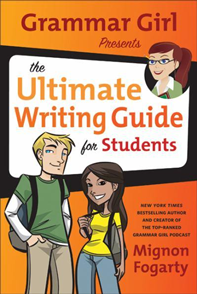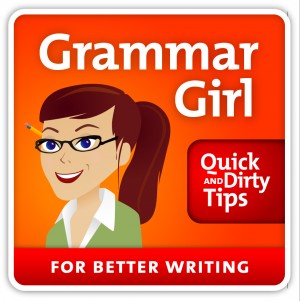advertisement
The following is a post from contributing writer Sarah Small of SmallWorld at Home.
I am a grammar and writing book junkie. I have two complete shelves of such guides, and I have no plans to stop collecting. But honestly, I don’t use them all. I use bits and pieces from some of them as I create lesson plans for my middle and high-school level English classes for homeschoolers.
But I found one this year that I love so much that I am requiring that my co-op students purchase it: The Ultimate Writing Guide for Students by the Grammar Girl herself, Mignon Fogarty.
I’ve been a long-time fan of the website Grammar Girl’s Quick and Dirty Tips for Better Writing. I love how Fogarty explains tricky grammar rules in a light, amusing fashion. For example, this explanation of bachelor’s degree on the Grammar Girl website is so simple but memorable:
Dawn wants to know how to write that someone was awarded a degree. Is it “bachelor’s degree,” “bachelors degree,” or “bachelor degree”?
A bachelor is not just a guy who eats out a lot, but also a person of either sex who has earned a type of degree from a university or college. Think of the degree as the property of the bachelor, with the apostrophe-s indicating possession: It is a bachelor’s degree.
The same is true for a master: He or she earns a master’s degree.
You don’t use capital letters, unless you’re writing the formal name of a particular degree:
- Aardvark earned a bachelor’s degree in ant behavior.
- Aardvark has a Bachelor of Science Degree in the Behavioral Dynamics of Edible Ants.
Grammar Girl’s Writing Guide for Students is much like her website. It is divided into five sections, which I’ve listed below with an example from each section:
Chapter 1: Parts of Speech
“A subjunctive verb is used to communicate such feelings as wishfulness, hopefulness, and imagination—things that aren’t real or true. For example, when the Cowardly Lion in The Wizard of Oz sings ‘If I were king of the forest,’ he is fantasizing about all the things he would do if he were brave. He’s not courageous—he’s just imagining—so if I were is the correct statement. I were often follows the word if, because if often means you are wishing or imagining.”
Chapter 2: Sentenced for Life
“Prepositional phrases are my favorite type of modifier, but if you are careless with their placement, they can turn your wonderful thoughts into foolish babbling.”
Chapter 3: Punch Up Your Punctuation
“The difference between a colon and a dash is subtle. They can both serve to introduce a related element after a sentence, but a dash is more sensational and informal mark than a colon. Think of a colon as part of a sentence that just ambles along. … A dash, on the other hand—well, it’s quite dramatic.”
Chapter 4: Quick and Dirty Tips:
“If you say you ‘could care less,’ you’re not saying what you really mean. I could care less is used so often that some people consider it an idiom, but many people find it annoying. The correct statement is I couldn’t care less.”
Chapter 5: Your Right to Write
“If you get irritated by repeatedly hearing your parents’ stories, you can understand how redundancy can annoy other people. … Redundancy is a subspecies of wordiness—not only are the words unnecessary, but you’ve already made the same point.”
Each chapter contains ample examples, Fogarty’s trademark quick and dirty tips, and pop quizzes. I find the layout user-friendly. The explanations are in black ink, and the examples are in orange. It isn’t busy or overloaded with graphics. And, well, honestly? This book is entertaining! Grammar Girl is witty without being cheesy, except for when she is trying to be cheesy.
So how can you use this book for your students?
As a grammar text: I am planning on assigning several sections each week for my high-school English students to read at home. (We meet once each week.) I’ll also be providing exercises for students to do for homework. This is where the book is limited—I am going to have to create my own exercises. I am planning to match up each section using exercises from free sites such as Purdue Online Writing Lab (OWL), Guide to Grammar and Writing, and KISS Grammar.
As a reference guide: This will be a fantastic tool for students to understand the “whys” of marks on essays and papers because I can refer a student to a specific rule in the book for clarification. For example, if a student uses “effect” instead of “affect,” I can note the page number in the guide where this rule is explained.
If you have another grammar program you like, I would still recommend buying this as a reference guide for your kids. It’s the best one in my whole collection!
This post contains affiliate links. The guide book, however, is from Sarah’s own personal collection.
Join 40,000+ Other Awesome People
Subscribe to the Real Life at Home weekly newsletter to get our latest content, exclusive free printables, learning activities, and ideas for celebrating with your kids all year


Have you created a curriculum schedule using the Grammar Girl books? I just ordered her books and would be willing to purchase it if you do since it would save me a huge amount of time.
Also, thank you for the Language Arts exercise website links….very appreciated.
Rachel, I haven’t, sorry! I just assigned certain pages and then either created exercises to go along with the reading or just found exercises on various language arts sites. Great idea, though!
I am looking for exercises to go with the book as well! Have you had any luck finding any?
Thanks!!